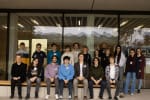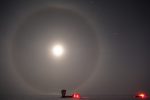The photos from last week are all indoor shots, but clearly auroras aren’t the only source of color at the Pole. Last week the station celebrated a New Orleans–themed cocktail party, hosted by the SPT and BICEP winterovers. Décor and dress code were in the spirit of Mardi Gras (colorful), and all attendees enjoyed an […]
News
IceCube Masterclass brings together students and scientists from around the world
This year, over 200 students across 20 research institutions in Belgium, Canada, Denmark, Germany, Thailand, Sweden, and the United States participated in the eleventh edition of IceCube Masterclass. The masterclasses were held between the months of January and May, with many of them running an in-person program. This year, the University of Utah and Chiang […]
Week 22 at the Pole
The moon from the previous week is long gone—with the darker skies, the stars and auroras get to take center stage. At the Pole last week, IceCube winterovers remained busy testing and verifying components of the new IceAct telescope. Connor also visited MAPO to help out the BICEP winterovers, and took the opportunity to photograph […]
Week 21 at the Pole
The moon returned to the Pole last week, and bright enough so that they could temporarily remove some window covers (something to get excited about in the dark winter months). The “moon” theme continued with a special video call last week featuring Fred Haise, NASA astronaut. He described his career both before and after the […]
Carlos Argüelles-Delgado named a CIFAR Azrieli Global Scholar
This year, IceCube collaborator and Harvard University physics professor Carlos Argüelles-Delgado is among 10 emerging research leaders selected for the 2024-2026 cohort of the Canadian Institute for Advanced Research (CIFAR) Azrieli Global Scholars program, generously supported by the Azrieli Foundation. This ambitious next-generation initiative provides two years of unrestricted funding to talented researchers tackling important and […]
Week 20 at the Pole
With record-breaking winds last week, the South Pole station spent a few days in lockdown mode, restricting off-station travel to critical operations only. Staying indoors might put a halt to outdoor photography plans, but it doesn’t hamper fun activities held indoors. Last week, the station had a burger bar (that’s IceCube winterover Kalvin, above, whipping […]
Week 19 at the Pole
There they are—those big, expansive, colorful auroras that seem to fill the sky! The highlight for last week at the Pole might have been the auroras, but it’s worth noting that capturing these lovely photographs required braving really cold temperatures and high winds. Still, auroras alone might be enough motivation for some folks to venture […]
Search for elusive sterile neutrino continues with improved high-energy muon neutrino reconstruction in IceCube
Neutrinos are tiny “ghostlike” particles that traverse long distances across the universe, interacting with matter only through the weak force. They come in three different types or “flavors”—electron, muon, and tau—and during their journey through the atmosphere and the Earth can transform from one flavor to another. This phenomenon, called neutrino oscillation, is a subject […]
Week 18 at the Pole
A very large moon halo dominated the sky, here seen above the South Pole Telescope when conditions were just right last week. IceCube’s winterovers were busy as usual last week, and a few of their activities took them outside. With clear weather, they were able to enjoy views of auroras (no photos though) in addition […]
Measurement of atmospheric neutrino oscillation parameters using convolutional neural networks with high precision
As cosmic rays crash into the Earth’s atmosphere, air showers containing atmospheric muons and neutrinos are produced. The atmospheric neutrinos are then detected by DeepCore, a denser array of sensors in the center of the IceCube detector at the South Pole. Compared to the main IceCube detector, DeepCore is sensitive to neutrinos down to energies […]









